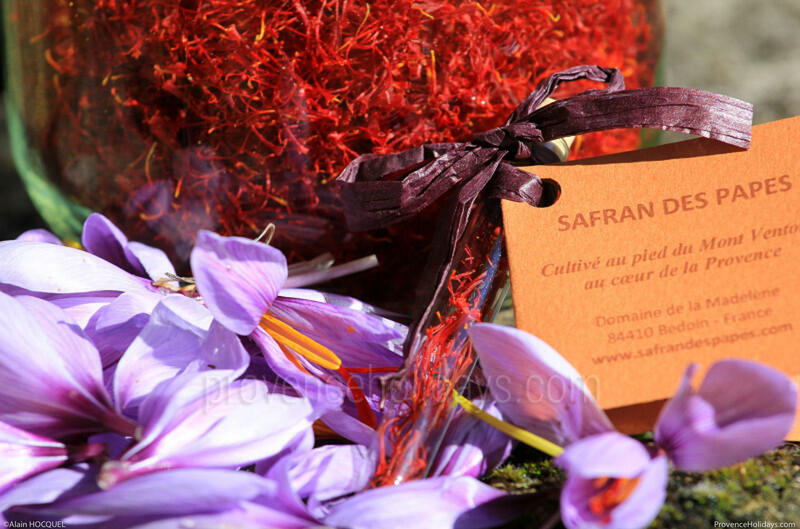Saffron
History
Saffron is a very old spice. It was long thought to originate in the Middle East or Kashmir, but some research has concluded that it is of European origin. In ancient times, the plant appeared in Greece, on the islands of Crete and Santorini, before spreading throughout the Mediterranean basin. In the Middle Ages, the spice trade became a very lucrative business. It was the popes of Avignon who brought the small purple flower from which saffron is made. The Europeans dominated the southern part of the Spice Route, while the eastern part remained under the control of the Arabs from the Middle East. It was in the 16th century that the French took over this trade and nicknamed the spice "red gold". In the 17th century, there were more than 160 saffron producers in Carpentras. At the end of the 19th century, France became one of the largest producers of saffron. Today, Iran is the largest producer in the world and Spain the largest in Europe. Production remains more confidential in France: saffron is produced in small farms without industrial machinery.
Varieties and Flavours
Saffron is the only spice made from a flower and the most expensive in the world. It is obtained from the pistil of the Crocus sativus. This reversed vegetation plant flowers in autumn. The purple flower consists of three petals and three sepals. The three bright yellow stamens are opposite the sepals. The pistil ends in three bright red stigmas with a characteristic smell. Saffron is obtained from these three dried stigmas.
Saffron can be recognised by its bitter taste and its hay-like scent. Saffron contains crocine, which gives the dishes a lovely golden yellow colour.
The Question on Everyone's Mind
How many flowers are needed to produce one kilogram of saffron?
It takes more than 150,000 Crocus sativus flowers; the equivalent of two football fields!
How to Eat It
Saffron is used in cooking. It is one of the main ingredients of bouillabaisse, the one that gives it its special taste. It is used in many specialities from all over the world: broths, paella, risotto, curries, stews, fish or meat dishes, tajines and in desserts. It can be bought in powder or in strands.
Note: in addition to its culinary qualities, saffron is also used for its therapeutic properties: it is an antidepressant, a sedative, an antiseptic, an anti-inflammatory, an antispasmodic, an aphrodisiac and a hormone regulator.
A Recipe
Scallops with Saffron:
|
Preparation time: 15 mins Cooking time: 7 mins and 2 mins for the scallops Difficulty: easy Cost: €€€ |
Ingredients for 4 persons : 20 scallops |
- Infuse your saffron in the cream for a few minutes.
- Heat a little butter in a saucepan and fry the finely chopped shallots. Brown them over a low heat and then deglaze with a dash of white wine. Leave to reduce.
- Add the saffron-infused cream and simmer.
- Add the juice of half an orange.
- Season and keep warm.
- Heat a little butter in a pan.
- Place your scallops in the pan and cook for 2 minutes on each side to sear them and give them a nice colour.
- Place the scallops in shallow dishes and pour a little sauce around them. Add a few chervil leaves. Season with a little pinch of salt. You can even grate a little orange zest to finish.
- Enjoy!
Where to Buy It
On the website of Safran Provence, which is a non-profit association whose objective is to relaunch and develop the cultivation of saffron in Provence. The association supports producers in their daily work, promotes saffron from Provence and helps with its marketing: https://www.safraniersdeprovence.fr/index.php/vente
To learn more about saffron, visit the blog of saffron grower Olivier Reboul, Terra t'air: www.terratair.com/Blog
You will find saffron on almost every market in Provence. Here are some addresses where you can buy it:
Chez les producteurs, ![]() 1500 route de Napollon, Aubagne.
1500 route de Napollon, Aubagne.
Les amis paysans, ![]() La Penne-sur-Huveaune.
La Penne-sur-Huveaune.
La Belle Ferme, ![]() 240 rue Berthelot, ZI Saint-Joseph, Manosque
240 rue Berthelot, ZI Saint-Joseph, Manosque
Graines de la vallée, peasant grocery and ACS, fair trade shop, ![]() 7bis rue Martinot, Aubagne
7bis rue Martinot, Aubagne
You can also visit a saffron farm, all year round, by appointment. For more information: www.provenceguide.com
Saffron Events
A Saffron Festival takes place in the second half of July in Sillans-la-Cascade: gourmet market on the theme of saffron, local products, conferences, culinary demonstrations, art craftsmen, activities for children, giant paella...

